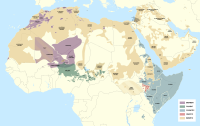Afroasiatic languages

Afroasiatic languages are a group of languages that people in Africa and the Middle East speak. They include languages like Arabic, Hebrew, Amharic, and Hausa. Just like when you speak English and you can understand someone who speaks Spanish or French, people who speak different Afroasiatic languages can understand each other too.
Think of it like this - imagine you have a box of different crayons. Some of the crayons might be green, some might be blue, some might be red, and some might be yellow. But even though they're different colors, they're still all crayons, right? Afroasiatic languages are kind of like that box of crayons. Even though they have different words and rules for how you use those words, they all belong to the same group of languages.
What makes Afroasiatic languages special is their history. They've been around for a very long time - thousands of years, even! The people who spoke these languages lived in different places and had different cultures, but they all shared some important things in common. They traded with each other, learned from each other, and sometimes even fought with each other. And over time, their languages started to sound more and more alike.
Today, even though Afroasiatic languages are spoken all over the world, they still have a lot in common with each other. For example, many of them have a special way of forming words called "root and pattern". This means that you can take a simple word like "book" and add different patterns to it to make new words like "library" or "bookcase". To someone who speaks an Afroasiatic language, this makes a lot of sense!
So, to sum it all up, Afroasiatic languages are a big group of languages spoken in Africa and the Middle East. They're special because they've been around for a really long time, and they share a lot of similarities even though they have different words and rules. Just like how all the crayons in your box are different colors but still belong together, all the Afroasiatic languages are different but still belong to the same family.
Think of it like this - imagine you have a box of different crayons. Some of the crayons might be green, some might be blue, some might be red, and some might be yellow. But even though they're different colors, they're still all crayons, right? Afroasiatic languages are kind of like that box of crayons. Even though they have different words and rules for how you use those words, they all belong to the same group of languages.
What makes Afroasiatic languages special is their history. They've been around for a very long time - thousands of years, even! The people who spoke these languages lived in different places and had different cultures, but they all shared some important things in common. They traded with each other, learned from each other, and sometimes even fought with each other. And over time, their languages started to sound more and more alike.
Today, even though Afroasiatic languages are spoken all over the world, they still have a lot in common with each other. For example, many of them have a special way of forming words called "root and pattern". This means that you can take a simple word like "book" and add different patterns to it to make new words like "library" or "bookcase". To someone who speaks an Afroasiatic language, this makes a lot of sense!
So, to sum it all up, Afroasiatic languages are a big group of languages spoken in Africa and the Middle East. They're special because they've been around for a really long time, and they share a lot of similarities even though they have different words and rules. Just like how all the crayons in your box are different colors but still belong together, all the Afroasiatic languages are different but still belong to the same family.
Related topics others have asked about:
